There are 13 species of turtles in Iowa. They range from terrestrial Wood and Box turtles to aquatic Softshell and Snapping turtles.
Iowa has several big rivers running through it such as the Mississippi and Missouri rivers. Across the state, you can find many lakes, streams, ponds, and other waterways that turtles want to call home.
If you’re interested in finding out more about these shelled reptiles, then let’s dive in and see what we can find.
Table of Contents
Wood Turtles in Iowa
1. Wood Turtle
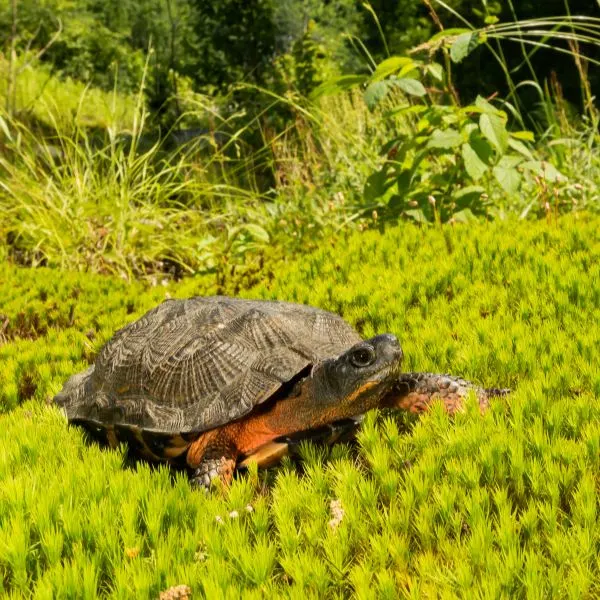
- Experience Level: Intermediate
- Family: Emydidae
- Scientific Name: Glyptemys insculpta
- Other Names: N/A
- Adult Size: 5.5 to 9 inches
- Life Span: 40 to 60 years
- Average Price Range: $250 to $500
- Conservation Status: Endangered
Wood turtles are an intelligent species mainly found in the Northeast, Cedar River region of the state. These turtles are quite terrestrial, but they will go into the water to find food and hibernate.
During the day they spend a lot of time roaming the forest floor. Here they eat berries, plants, fungi, insects, and worms. When food isn’t very plentiful, these turtles have figured out how to get dinner to come to them.
Wood turtles will stomp the ground and “dance” to imitate the sound of rain. Worms, thinking the earth is about to get soaked, come to the surface, where the turtle gobbles them up.
Wood turtles are small, endangered, beautiful looking reptiles. They have brown carapaces (upper half of the shell) that resemble wood grain. The scutes are slightly raised and have deep growth rings, they really look like they were carved by skilled hands.
This turtle’s head is usually black but may contain some yellow, orange, or red coloration. The limbs are warm colored and occasionally carry black spots.
Wood turtles are endangered because it takes a long time for them to reach sexual maturity and predators eat the eggs and hatchlings. They also face poaching and habitat destruction.
Pond Sliders in Iowa
2. Red Eared Slider

- Experience level: Beginner
- Family: Emydidae
- Scientific Name: Trachemys scripta elegans
- Common Name: Pond slider, Red-eared terrapin, Water slider
- Average Adult Size: 6 – 8 inches
- Life Span: 20 to 40 years
- Average Price Range: approximately $30 to $100
- Conservation Status: Least concern
If you’ve seen little active turtles swimming around in tanks at the pet store, you’re likely looking at a Red Eared Slider. These are one of the most popular turtles around the world. They are also quite invasive and not an Iowa native.
Most likely they escaped from their enclosure or were let free from someone who couldn’t care for the pet. What makes these turtles so invasive is they out-breed, out-eat, and outperform most other species of turtles.
They are also habitat generalists and omnivores that will eat nearly anything they can find.
These turtles are medium sized and often congregate on basking spots in large numbers. Red Eared Sliders will often climb on top of other basking turtles while trying to get the perfect sunny real estate.
They have green or dark brown carapaces that have a lot of markings. As they age, these markings tend to fade, and the shell darkens. Their head and limbs have yellowish stripes, but their most identifying marks are the elongated red spots behind their eyes.
Though they are excellent swimmers, Red Eared Sliders prefer slow moving and shallow waters. They also search out waterways with plenty of basking spots and a lot of vegetation.
Snapping Turtles in Iowa
3. Common Snapping Turtle
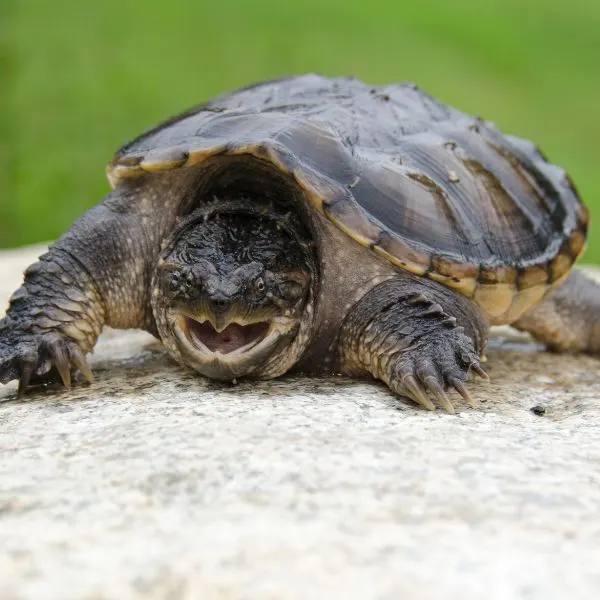
- Experience level: Intermediate to Expert
- Family: Chelydrida
- Scientific Name: Chelydra Serpentina
- Other Names: Snapping Turtle, Snapper, Eastern Snapping Turtle
- Average Adult Size: 8 to 20 inches
- Life Span: 30 – 50 years
- Average Price Range: Approximately $40 to $120
- Conservation Status: Least concern
Found in many of Iowa’s waterways and rivers, the Common Snapping turtle is one of the largest turtles found here. While they often average over a foot long, some older Snappers can reach lengths of 20 inches.
These big turtles have large legs with sharp claws, a long tail, nearly as long as the carapace, and long necks. When they are found on land, they may hiss, show aggression, and bite.
In the water, Snapping turtles prefer to hide in the mud and swim away from any potential threats. They spend so much time in the water their dark brown or black shells often grow algae. They even prefer to bask by just swimming up to the surface of the water.
Common Snapping turtles will leave the water to find new homes, and females will search for sandy, slightly sloping banks in which to lay their eggs.
Though mostly carnivorous, the Snapping turtle will also eat algae and vegetation. Living foods include anything they can get into their mouths such as frogs, fish, smaller turtles, and the occasional waterfowl. Waterfowl predation has only been documented a few times.
Painted Turtles in Iowa
4. Western Painted Turtle

- Experience Level: Beginner
- Family: Emydidae
- Scientific Name: Chrysemys Picta Belli
- Other Names: N/A
- Adult Size: Between 4 and 10 inches
- Life Span: Between 30 and 50 years
- Average Price Range: Between $30 and $150
- Conservation Status
Painted turtles are another common pet species because they are very colorful and active. They also have a calm demeanor and take well to home enclosures.
The Western Painted turtle is often confused with the Red Eared slider as they do have a similar appearance. The main difference is that Painted turtles don’t have the telltale red marks behind their eyes.
Painted turtles have smoother and flatter carapaces, and their yellow stripes are usually thicker, especially on their heads. Plastrons (lower part of the shell) are orange to red and have darker patterns, whereas Red Eared Sliders have a yellow plastron with black spots.
You’ll find these turtles all around Iowa’s slower moving waterways. They like places with plenty of vegetation, soft bottoms, and access to basking spots.
These turtles are omnivores and will eat aquatic vegetation, algae, fish, insects, crayfish, and mollusks.
5. Blanding’s Turtle

- Experience Level: Intermediate
- Family: Emydidae
- Scientific Name: Emydoidea blandingii
- Other Names: N/A
- Adult Size: 5 to 8 inches (12.5 to 20 cm)
- Life Span: Up to 80 years
- Average Price Range: $300 to $450
- Conservation Status: Endangered
Named after naturalist William Blanding, these colorful turtles have distinct yellow chins and throats. They have a dark, yellow speckled, domed carapace. Their plastron is also yellow and partially hinged.
They can pull themselves inside their shells, but they can’t completely close themselves like Box turtles.
Though they can be found throughout Iowa, and several other states, and Iowa, they don’t have a large population. Canada and most states list the Blanding’s turtle as endangered, they don’t have the same federal listing.
One interesting fact about these turtles is they don’t seem to show signs of aging. They can live to nearly 100 years old, and still reproduce in their 8th and 9th decade.
Blanding’s turtles live in shallow marshes and wetlands. Sometimes they explore across the land, but they like to stay close to the water.
They are omnivorous and feed on crayfish, worms, insects, fish, and the occasional water plant.
Musk Turtles in Iowa
6. Eastern Musk Turtle
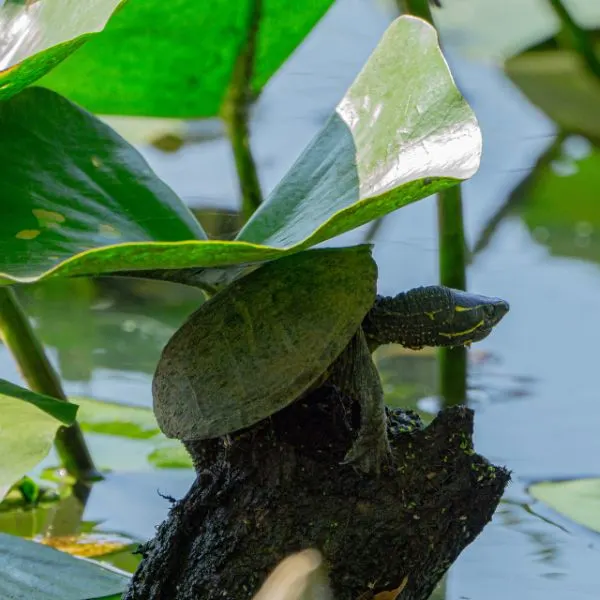
- Experience Level: Intermediate
- Family: Kinosternidae
- Scientific Name: Sternotherus odoratus
- Other Names: Common Musk turtle, Stinkpot
- Adult Size: 4 to 5 inches (10 to 12.5 cm)
- Life Span: 30 to 50 years
- Average Price Range: $30 to $120
- Conservation Status: Least concern
Eastern Musk turtles are also known as “Stinkpots” due to the nasty smelling substance they can emit from their musk glands. When threatened or bothered they will release their musk from the glands near their back legs.
These turtles prefer shallow, still, or slow-moving habitats with a lot of vegetation. They often climb along the vegetation to get to the surface for air.
While they spend most of their time in the water, they will sometimes leave the water and head to the trees. Yes, these turtles are accomplished, climbers. They climb trees in search of spiders and insects to eat.
Common Musk turtles are small and have dark, unmarked shells. On their heads, they have yellow or white stripes that start at the snout and move back to the neck.
Musk turtles are omnivores. They like to search along the vegetation for mollusks, fish, tadpoles, insects, and crayfish.
Mud Turtles in Iowa
7. Yellow Mud Turtle
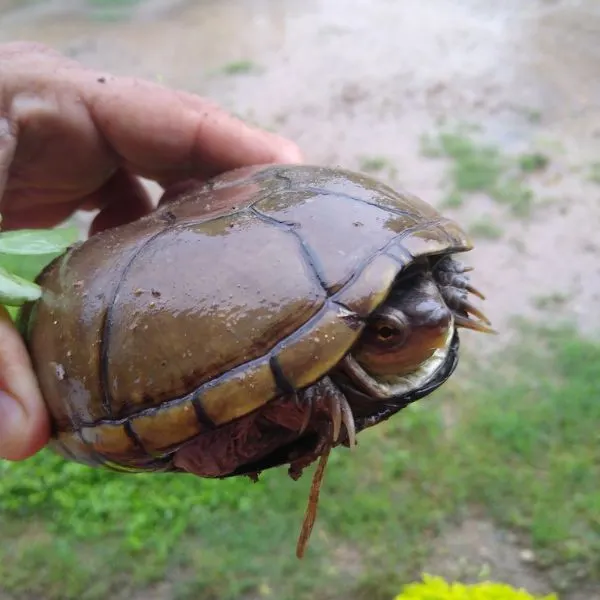
- Experience level: Intermediate
- Family: Kinosternidae
- Scientific Name: Kinosternon flavescens
- Common Name: Mud Turtle, Yellow Mud Turtle
- Average Adult Size: 5 – 7 inches
- Life Span: 40 years
- Average Price Range: Approximately $80 to $300
- Conservation Status: Least concern
Once distinguished as the Illinois Mud turtle, there was quite a debate and they are now more commonly known as Yellow Mud Turtles.
They are only found in small areas along the Mississippi river, small ponds, or marshes. They prefer muddy bottoms where they can bury themselves when they hibernate.
To identify a Yellow Mud turtle, look for an unmarked, domed, smooth dark colored carapace, and a lighter—often yellow—plastron. Their skin is dark colored on the top, and lighter yellow, tan, or cream colored on the underside.
These turtles will eat fish, frogs, tadpoles, insects, mollusks, small crustaceans, and aquatic plants.
Softshell Turtles in Iowa
8. Midland Smooth Softshell Turtle

- Experience level: Intermediate
- Family: Trionychidae
- Scientific Name: Apalone Mutica
- Other Names: N/A
- Average Adult Size: 5 – 14 inches
- Life Span: 10 – 20 years
- Average Price Range: $50 – $150
- Conservation Status: Least Concern
Smooth Softshell turtles are found in many rivers in Iowa. They prefer fast moving waters with soft bottoms but occasionally are found in ponds and slow-moving streams.
These turtles lack a hard shell. Instead, they have a soft, leathery, or rubbery carapace that allows them to breathe through their skin. This way they can stay submerged for long periods of time.
Softshell turtles tend to have the same color skin as their carapace and have smaller, light colored plastrons. The Midland Smooth Softshell turtle ranges from light brown to grey, or dark brown.
Spots or other markings may be seen on the carapace. On their face, you’ll often see stripes running from the long snout to the neck.
Though most Softshell turtles are quite aggressive on land, this particular species is more laid back. They can still scratch with their long claws, and break the skin with their sharp beak if they bite, so be very careful when handling them.
The Midland Smooth Softshell turtle is mostly carnivorous. They will eat fish, tadpoles, crayfish, and insects.
9. Spiny Softshell Turtle
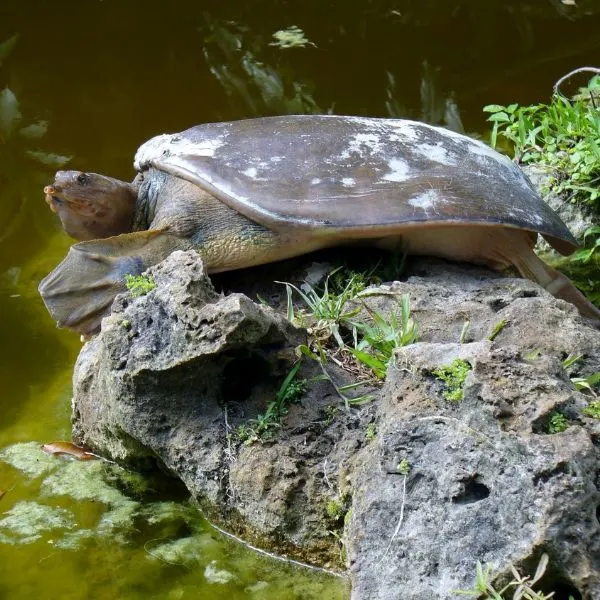
- Experience Level: Intermediate to Expert
- Family: Trionychidae
- Scientific Name: Apalone spinifera
- Other Names: N/A
- Adult Size: 5 to 9 ½ inches for males, 10 to 20 inches for females
- Life Span: Between 20 and 50 years
- Average Price Range: Between $20 and $120
- Conservation Status: Threatened in some areas
These turtles are the longest in Iowa, some reaching up to 20 inches long. You may find two species of Spiny Softshell turtles in this state. Eastern and Western Spiny Softshell turtles can be found across the state and their habitats often overlap.
There is much debate about whether these two species deserve their own distinction, or whether they should be grouped together. One of the reasons is they look so similar to one another, it’s very difficult to tell them apart.
Like all Softshell turtles, the Spiny Softshell lacks a hard carapace. Instead, their back is made up of cartilage and bony structures and covered in a thick skin. Unlike Smooth Softshells, this species has fleshy spikes along the front ridge and first half of the shell.
These turtles and all softshell species are very fast and accomplished swimmers. They are also quite agile and quick on land as well. Come to think of it, maybe it was actually a Softshell turtle and not a tortoise that raced the hare in that old fable.
The habitat of Spiny Softshell turtles is similar to the smooth species, and these too are mostly carnivores. Active hunters and ambush predators, these turtles will eat crayfish, small fish, amphibians, insects, and even waterfowl.
Map Turtles in Iowa
10. Northern Map Turtle
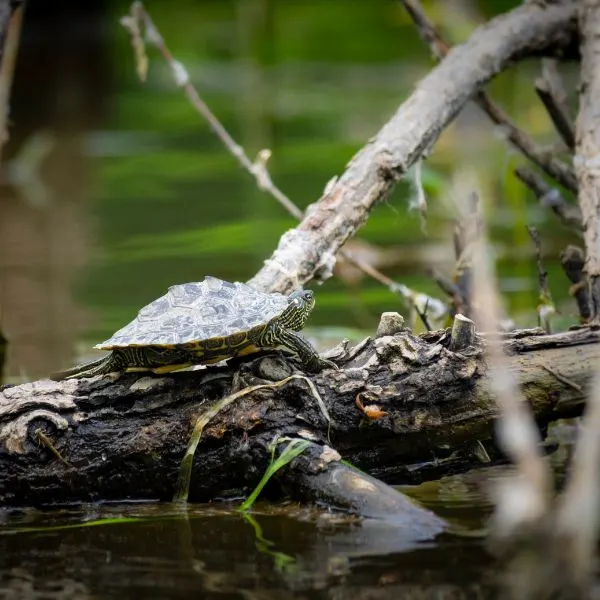
- Experience Level: Beginner
- Family: Emydidae
- Scientific Name: Graptemys geographica
- Other Name: Common map turtle
- Adult Size: Between 4 and 10 ½ inches
- Life Span: 15 to 20 years
- Average price range: Between $20 and $60
- Conservation Status: Least concern
These beautiful turtles are named for their markings. Northern Map turtles have dark brown or olive green shells and yellow patterns that resemble the contours of a map. At first glance, you may think this is a Painted turtle.
Small yellow spots behind the eyes separate the Common Map turtle from other species, and they tend to get bigger than most Painted turtles.
Northern Map turtles prefer larger bodies of water with plenty of basking spots. These turtles are shy and will flee to the water at the first disturbance. You may not see anything other than the rings on the water that signified there were once turtles on the fallen log.
Zebra mussels, clams, and other hard-shelled aquatic creatures make up most of this turtle’s diet. Females have bigger heads and stronger jaws to bite through the hard shells of these filter feeders.
11. Ouachita Map Turtle
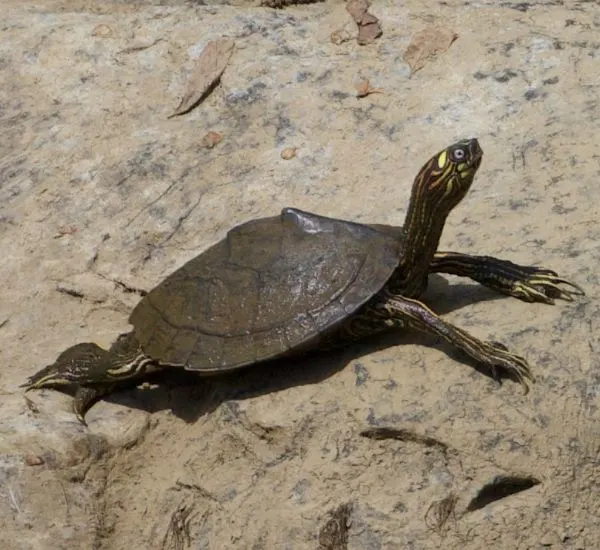
- Experience Level: Beginner
- Family: Emydidae
- Scientific Name: Graptemys ouachitensis
- Other Names: Southern Map turtle
- Adult Size: 3.5 to 10 inches (9 to 25.5 cm)
- Life Span: 15 to 20 years
- Average Price Range: $40 to $100
- Conservation Status: Least concern
Ouachita Map turtles can be distinguished from other Map turtles by the large yellow spots on the sides of their heads. Their carapace is olive green with contoured markings and a prominent keep along the middle.
This ridge is less pronounced on the much larger females. Both the male and female Ouachita Map turtles have serrations on the rear of their shell.
Their eyes are remarkable and stunning. They have bright light blue to white irises with a dark line running horizontally across the eye.
These turtles prefer stagnant, and slow-moving waters. They like marshlands, swamps, and ponds, but they have been known to inhabit slow moving rivers and streams.
The Ouachita Map turtle is omnivorous. They eat fruits, berries, plants, insects, fish, and whatever else they come across.
12. False Map Turtle
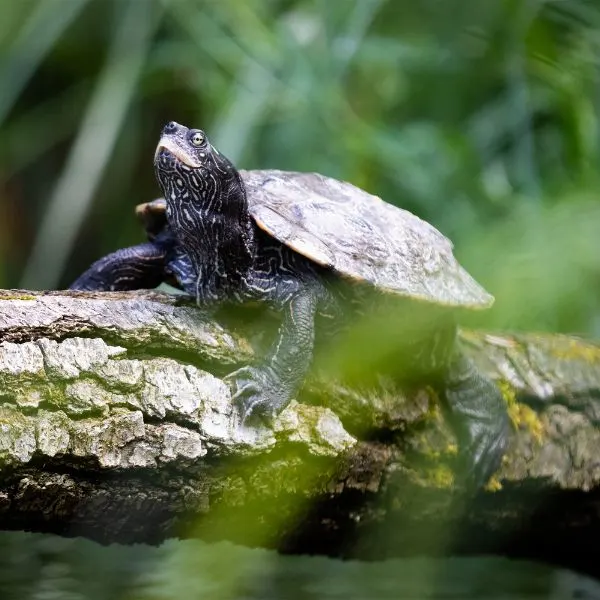
- Experience Level: Beginner
- Family: Emydidae
- Scientific Name: Graptemys pseudogeographica
- Other Names: Sawback turtle
- Adult Size: 3.5 to 10.5 inches (9 to 26.5 cm)
- Life Span: 30 to 50 years
- Average Price Range: $6 to $40
- Conservation Status: Least concern
The False Map turtle usually dwells in areas near the Mississippi and Missouri rivers that run through Iowa. They rarely travel far from the water and like to bask on outcrops over the water’s surface.
These turtles spend a lot of time basking and will often do so in large congregations. This helps them stay alert to danger.
Occasionally the False Map turtle is called the “Sawback turtle” because of the saw-toothed rear of the carapace. It’s often brown or olive colored with a cream colored plastron. The body, head, and limbs are grey, brown, or black with yellow stripes.
False Map turtles are omnivorous. They will eat vegetation, seeds, fruits, crayfish, invertebrates, and fish.
Box Turtles in Iowa
13. Ornate Box Turtle
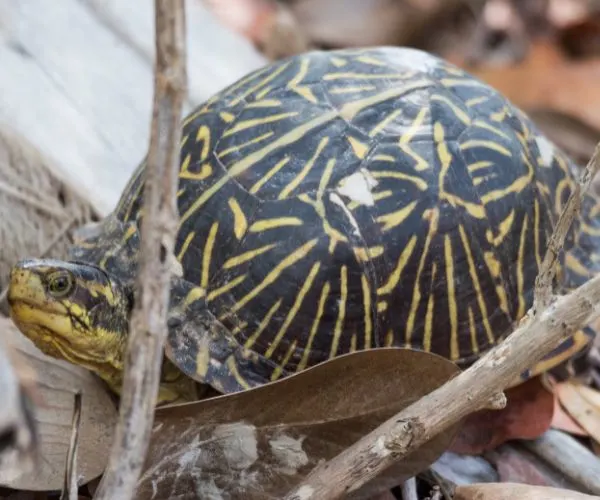
- Experience Level: Intermediate to Expert
- Family: Emydidae
- Scientific Name: Terrapine ornata
- Other Names: Box Tortoise, Western Box Turtle
- Adult Size: 4 to 5 inches (10 to 12.5 cm)
- Life Span: 30 to 40 years
- Average Price Range: $150 to $450
- Conservation Status: Near threatened
Ornate Box turtles have dark shells with bright orange or yellow starbursts on their scutes. Their skin and scales are also dark brown or black with light colorations. Often the face of Ornate Box turtles looks like it was splashed with paint.
The only fully terrestrial turtle, the Ornate Box turtle is able to fully enclose itself inside its shell. The plastron has hinges at the front and back that can close.
Instead of spending time in the water, the Ornate Box turtle calls grasslands and sand prairies home. To help regulate their body temperature they will burrow in sand and soft soil to cool off or to hibernate.
Agricultural development and cattle grazing lands threaten this turtle’s habitat.
When it comes to feeding, these turtles are opportunistic omnivores. They will eat grasses, fruits, berries, fungi, insects, worms, and occasionally carrion.
Wrapping up
There are 13 different turtle species found across the Hawkeye State. While out exploring nature, keep your eyes open, you never know, you may see a few different species of these turtles.
If you are looking to own one of these amazing turtles, please don’t take them from the wild. Most turtles are not only federally protected, but they won’t do well in captivity. Instead look for a quality, licensed breeder or pet store that has the pet you’re looking for.
Captive bred turtles fare much better in home enclosures than wild turtles. Also, be aware that some of these animals can live for several decades, so you’ll have a companion that will last a very long time.
While you’re here, leave us a little comment before you take off. Let us know about anything you’d like to know about or interesting stories about a turtle experience. Or you could just leave us a “Hi,” we love to hear from our readers.
Other nearby states
- Turtles in Illinois
- Turtles in Minnesota
- Turtles in Missouri
- Turtles in Nebraska
- Turtles in Wisconsin
